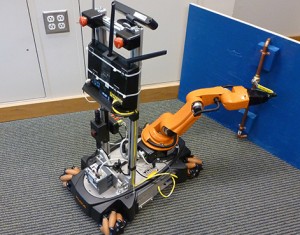May 8 2014
University of Washington electrical engineers have developed telerobotics technology that could make disaster response faster and more efficient.
 This robot has a mounted camera and router to transmit the robot’s view of the scene, and built-in haptics technology allows the operator to receive force feedback from the robot. Credit: U of Washington
This robot has a mounted camera and router to transmit the robot’s view of the scene, and built-in haptics technology allows the operator to receive force feedback from the robot. Credit: U of Washington
They are working with a team of eight other organizations as part of the SmartAmerica Challenge, an initiative designed by two of this year's Presidential Innovation Fellows to encourage new technologies that help society in our increasingly connected world.
"We are working on an application of technology that's clearly for the public good, and that's what motivated our team's idea," said Howard Chizeck, a UW professor of electrical engineering and team leader from the university.
UW engineers and partner organizations will test and demonstrate their disaster-response technology for the news media and university community from 1 to 4 p.m. May 13, in the Electrical Engineering Building atrium (second floor), before presenting their project in Washington, D.C., in June. The team formed about six months ago at an initial brainstorming gathering in D.C.
The group, called the Smart Emergency Response System team, aims to combine existing "smart" technologies to better serve society during disaster and crisis response. This includes using teleoperated robots for rescues and safety operations; a high-tech dispatch system that gathers information from cameras and sensors and pushes it out to first responders; drones for damage surveillance and rescues; and vests outfitted with sensors and GPS tracking to be worn by search-and-rescue dogs.
"The key is we're taking many developed technologies from different organizations and putting them together in a way that's innovative," Chizeck said.
In addition to the UW, the Smart Emergency Response System team members are BluHaptics, Boeing Co., MathWorks, Massachusetts Institute of Technology Media Lab, National Instruments, North Carolina State University, University of North Texas and Worcester Polytechnic Institute.
At the UW, engineers in Chizeck's lab as well as at spinout company BluHaptics are leading the effort to develop robots that can interact more seamlessly with human operators. The technology lets a robot operator actually feel feedback in the form of pressure on his or her hand controller from a robot on the ground. This force feedback can help the operator avoid objects and realize when the robot’s arm has reached its limits. Known as haptic feedback, this technology essentially instructs the human operator through touch sensation as though the person were in the field with the robot.
"The idea is really to combine the skills and situational awareness of a human operator with the precision and repeatability of an autonomous robot. This way we can rely as much on a robot as we can on a human," said Fredrik Ryden, co-founder and vice president for engineering at BluHaptics, and a postdoctoral researcher with the UW Center for Commercialization.
For example, a first responder at a disaster scene could control a robot from a nearby command center to go into the field and turn off a gas valve. The responder could see on a computer screen from the robot's field of vision and steer it toward the valve. When the robot approaches the correct valve, it would send force feedback to help the human operator make a safe and efficient valve turn.
Using a robot from National Instruments, based in Austin, Texas, the UW engineering team mounted a camera and high-end router to allow the human operator to see from the robot's perspective. The idea is for the human to feel immersed in the robot's landscape, seeing depth and real-time movements and receiving force feedback from the robot.
This telerobotics technology, combined with the other smart systems, could help with future disaster responses and even create jobs, particularly for veterans, team leaders said. The robotics technology itself is not complicated to operate and could be used by anyone, not just highly trained technicians.
"We are trying to show that these robotics and communication system can be used by anyone. It's really about making something that's simple to use," Ryden said.